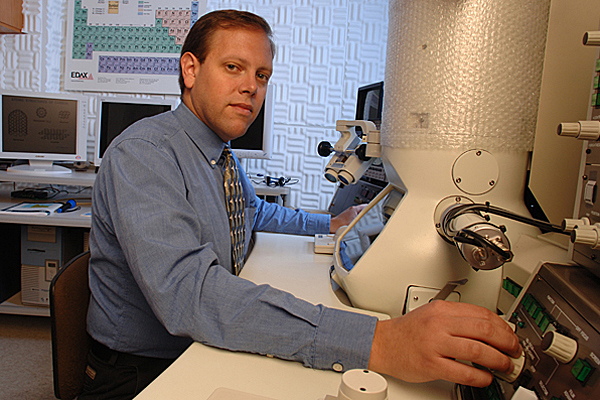Home > Press > Size matters: UD receives grant to enhance infrastructure for nanomaterials research, education
 |
| Erik Thostenson |
Abstract:
Nanomaterials are tiny but mighty, offering the potential for use in a vast array of applications from fuel cells to drug delivery systems. Their size—the diameter of a nano-fiber is approximately one-thousandth that of a human hair—underlies both their power and the challenge of harnessing that power.
Size matters: UD receives grant to enhance infrastructure for nanomaterials research, education
Newark, DE | Posted on September 7th, 2011"Strange things happen when materials get that small," says Erik Thostenson, a mechanical engineering professor at the University of Delaware. "Exploiting the unique properties of nanomaterials requires a highly integrated approach involving scientists and engineers from diverse fields. For engineers to be well versed in nanotechnology, it's crucial to introduce the topic early."
Thostenson is leading a team that recently received a $200,000 grant from the National Science Foundation's Nanotechnology Undergraduate Education (NUE) in Engineering program. The grant will support research-based educational opportunities for undergraduate students in a number of areas, including energy applications and sensing and actuating devices for smart multifunctional materials. UD's Center for Composite Materials will serve as a focal point for active exchange and interaction in the program.
"We need to provide our students with a solid scientific and technical base as well as an understanding of emerging technologies and the unique properties of nanomaterials if we want to prepare them to engineer new smart structures and devices at the nanoscale," Thostenson says.
Specific objectives of the program include developing new course materials as an outgrowth of the research, as well as actively involving students in project-based activities to generate excitement about nanotechnology and promote interdisciplinary collaboration.
"We have a strong infrastructure in place at the center for these types of interdisciplinary projects through our high level of student involvement in professional organizations like SAMPE and ASME," says CCM director John W. (Jack) Gillespie Jr. "These kinds of activities are a great way to build scientific leadership skills and teach students how to effectively work in teams."
The NUE grant will also facilitate the involvement of underrepresented minorities in engineering through UD's Resources to Insure Successful Engineers (RISE) and Women in Engineering (WIE) programs.
####
About University of Delaware
Founded in 1974, CCM is an internationally recognized model for industry-university-government cooperative research. Over its 37-year history, CCM has been home to numerous centers of excellence, including one of the first National Science Foundation Engineering Research Centers (NSF-ERCs), in 1985.
About the research team
The UD NUE team encompasses expertise in all aspects of nanoscale materials, including synthesis, manufacturing, modeling, processing, and characterization. Faculty members include Erik Thostenson, assistant professor in the Department of Mechanical Engineering; Tsu-Wei Chou, Pierre S. du Pont Chair of Engineering; Jack Gillespie, CCM director and Donald C. Phillips Professor; Joshua Hertz, assistant professor of mechanical engineering; and Bingqing Wei, associate professor of mechanical engineering.
For more information, please click here
Contacts:
University of Delaware
Office of Communications & Marketing
302-831-NEWS
Copyright © University of Delaware
If you have a comment, please Contact us.Issuers of news releases, not 7th Wave, Inc. or Nanotechnology Now, are solely responsible for the accuracy of the content.
| Related News Press |
News and information
![]() Simulating magnetization in a Heisenberg quantum spin chain April 5th, 2024
Simulating magnetization in a Heisenberg quantum spin chain April 5th, 2024
![]() NRL charters Navy’s quantum inertial navigation path to reduce drift April 5th, 2024
NRL charters Navy’s quantum inertial navigation path to reduce drift April 5th, 2024
![]() Discovery points path to flash-like memory for storing qubits: Rice find could hasten development of nonvolatile quantum memory April 5th, 2024
Discovery points path to flash-like memory for storing qubits: Rice find could hasten development of nonvolatile quantum memory April 5th, 2024
Govt.-Legislation/Regulation/Funding/Policy
![]() NRL charters Navy’s quantum inertial navigation path to reduce drift April 5th, 2024
NRL charters Navy’s quantum inertial navigation path to reduce drift April 5th, 2024
![]() Discovery points path to flash-like memory for storing qubits: Rice find could hasten development of nonvolatile quantum memory April 5th, 2024
Discovery points path to flash-like memory for storing qubits: Rice find could hasten development of nonvolatile quantum memory April 5th, 2024
![]() Chemical reactions can scramble quantum information as well as black holes April 5th, 2024
Chemical reactions can scramble quantum information as well as black holes April 5th, 2024
Academic/Education
![]() Rice University launches Rice Synthetic Biology Institute to improve lives January 12th, 2024
Rice University launches Rice Synthetic Biology Institute to improve lives January 12th, 2024
![]() Multi-institution, $4.6 million NSF grant to fund nanotechnology training September 9th, 2022
Multi-institution, $4.6 million NSF grant to fund nanotechnology training September 9th, 2022
Announcements
![]() NRL charters Navy’s quantum inertial navigation path to reduce drift April 5th, 2024
NRL charters Navy’s quantum inertial navigation path to reduce drift April 5th, 2024
![]() Discovery points path to flash-like memory for storing qubits: Rice find could hasten development of nonvolatile quantum memory April 5th, 2024
Discovery points path to flash-like memory for storing qubits: Rice find could hasten development of nonvolatile quantum memory April 5th, 2024
Grants/Sponsored Research/Awards/Scholarships/Gifts/Contests/Honors/Records
![]() Discovery points path to flash-like memory for storing qubits: Rice find could hasten development of nonvolatile quantum memory April 5th, 2024
Discovery points path to flash-like memory for storing qubits: Rice find could hasten development of nonvolatile quantum memory April 5th, 2024
![]() Chemical reactions can scramble quantum information as well as black holes April 5th, 2024
Chemical reactions can scramble quantum information as well as black holes April 5th, 2024
|
|
||
|
|
||
| The latest news from around the world, FREE | ||
|
|
||
|
|
||
| Premium Products | ||
|
|
||
|
Only the news you want to read!
Learn More |
||
|
|
||
|
Full-service, expert consulting
Learn More |
||
|
|
||








